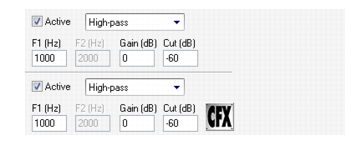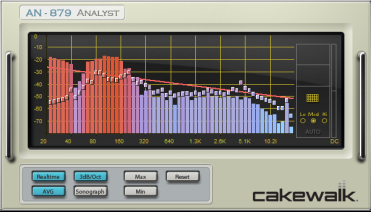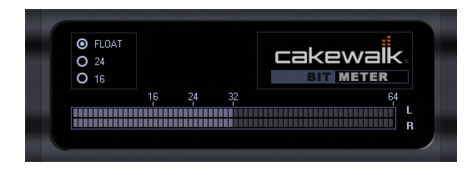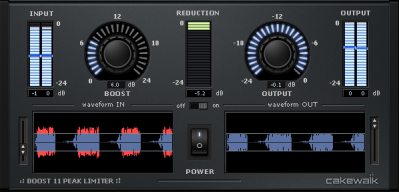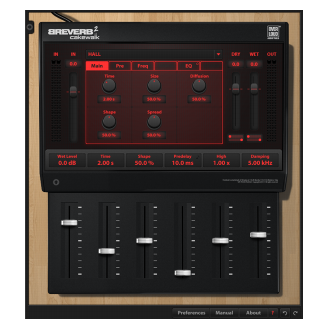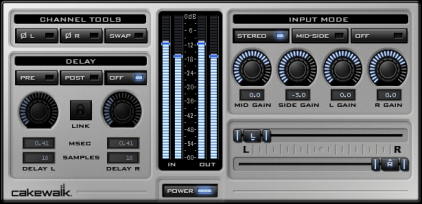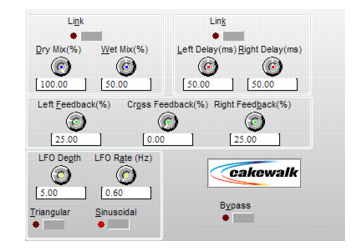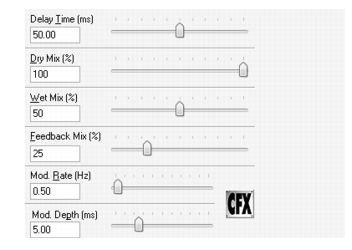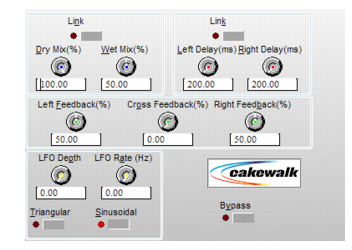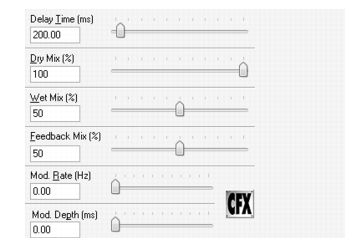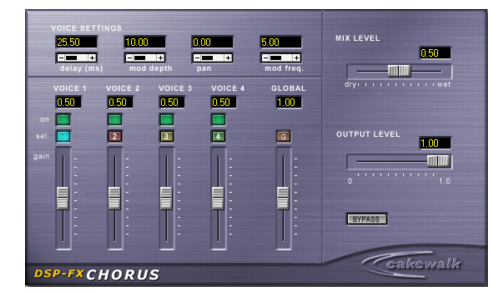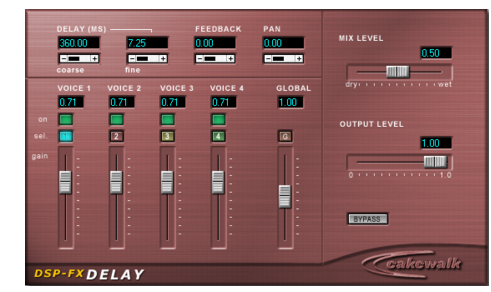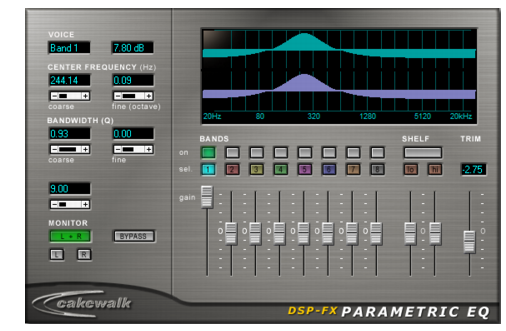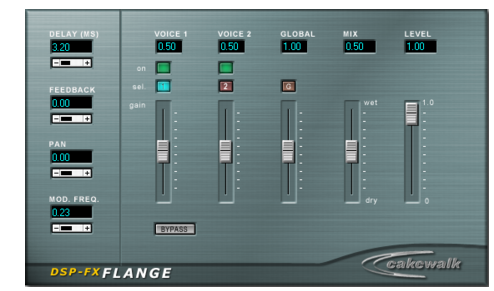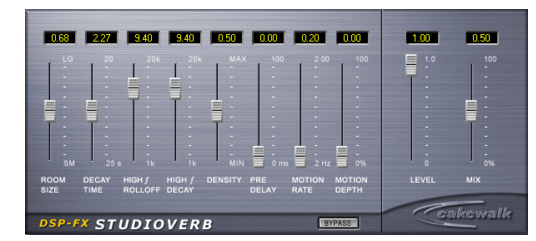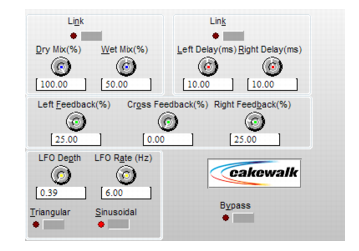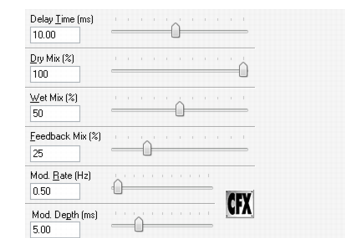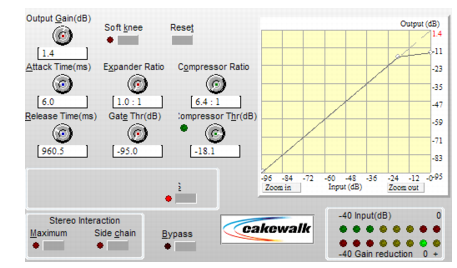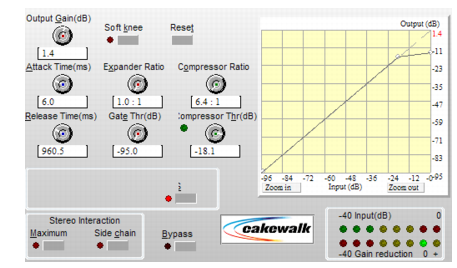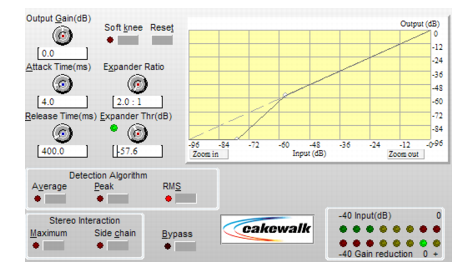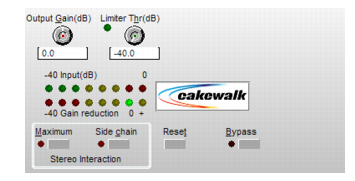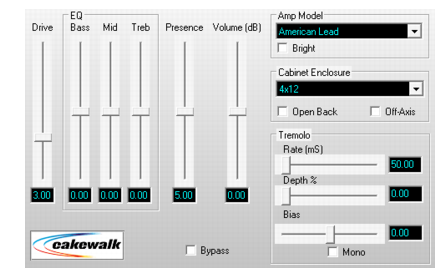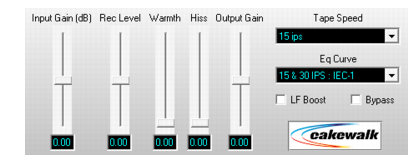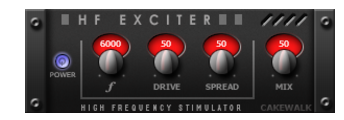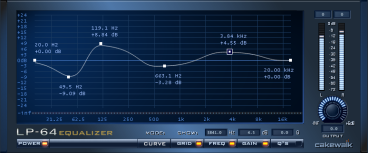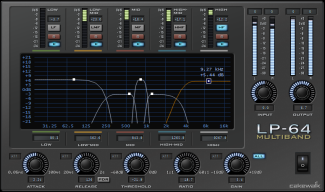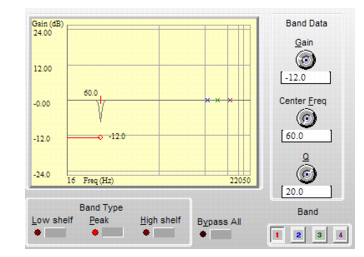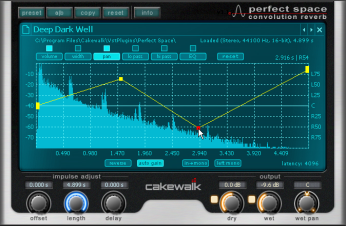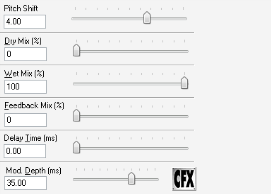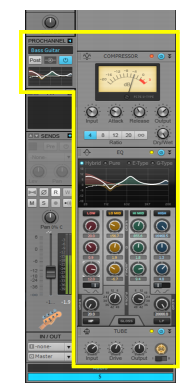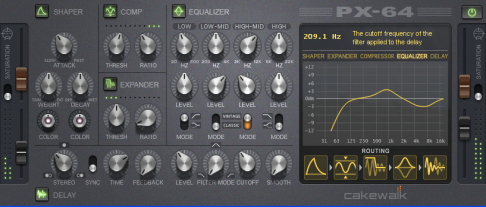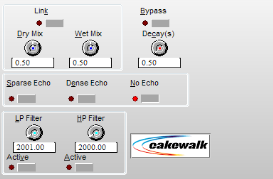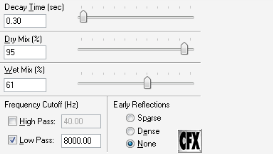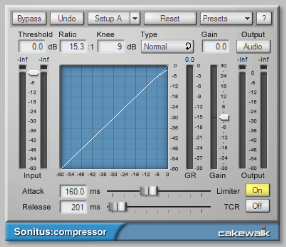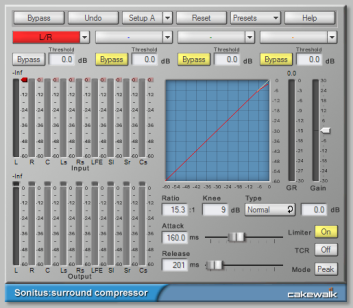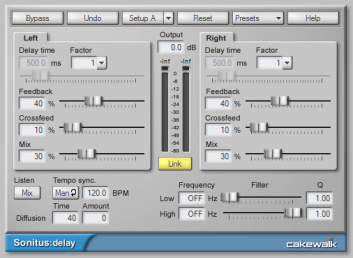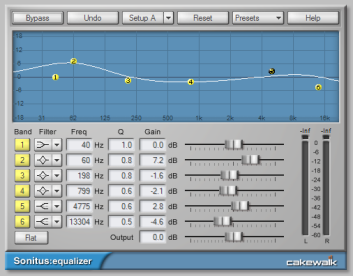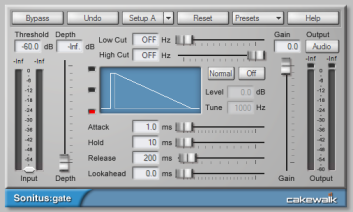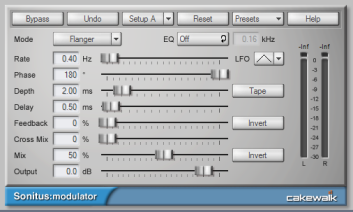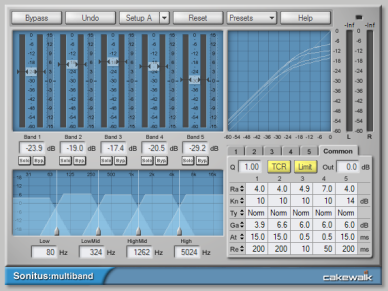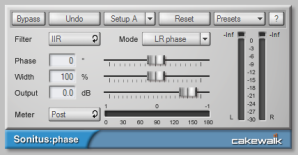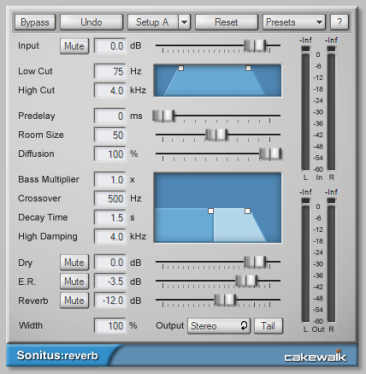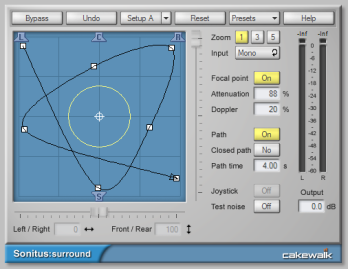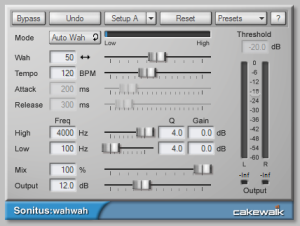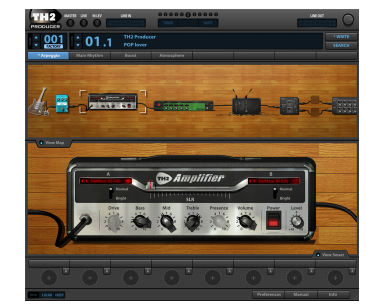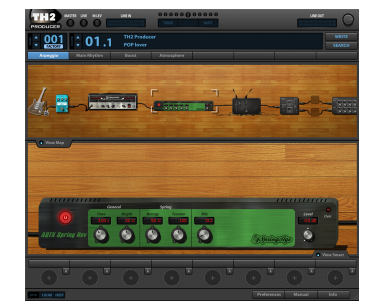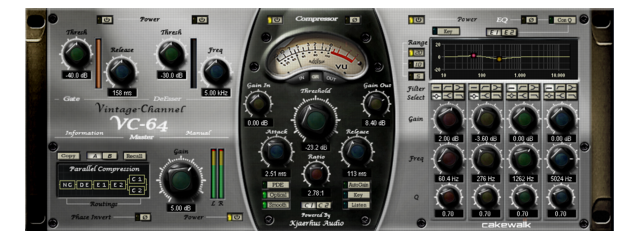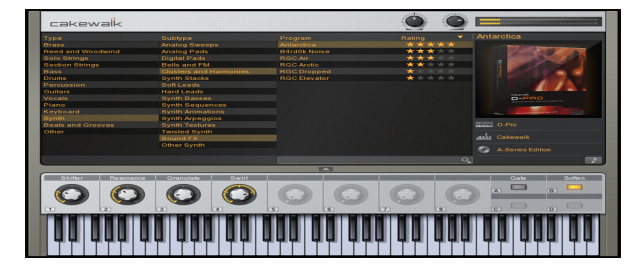Alias Factor combines bit crushing and low pass filtering in a unique way, allowing you to decimate your audio to create tones as varied as vintage samplers, cell phones, or old video games. Decimator effects are nothing new, but
Alias Factor generates this effect using a special technique that generates aliasing without the unwanted harsh effects provided by other options, offering sounds that are grainy in a “smooth” and organic way.
Alias Factor also allows for further creation of attention grabbing new timbres by linking a low pass resonant filter to the decimator for a new means of tweaking your sound.
|
|
Spectrum mode. Vertical axis represents dB, horizontal axis represents frequency (as pictured above).
|
|
|
Sonograph mode. This mode displays a color-coded historical representation of the audio. Level is indicated by color; vertical axis represents frequency. Horizontal axis represents time, with NOW being at the right edge, and the history going toward the left.
|
See the benefits of SONAR's 64-bit audio engine in action with the Bit Meter VST plug-in: . A valuable tool for monitoring the digital activity of your audio stream. View output word length, dynamic range, signal peaks, and more to analyze the quality of your digital signal.
The Boost 11 Peak Limiter is a transparent peak limiting and volume maximizing plug-in for mixing and mastering purposes; it is designed to reduce peak levels without coloring the sound. Boost 11 uses a “look-ahead” limiter algorithm to prevent output clipping and PDR (Program Dependent Release) to minimize pumping (audible fluctuations of the volume) and maximize the loudness. “Look-ahead” means the limiter analyzes the audio input ahead of time by delaying the output for approximately 1.5ms. Boost 11 supports sampling rates up to 192 kHz, mono and stereo operation, and double precision processing.
For more information, see the Boost 11 Peak Limiter online Help.
BREVERB SONAR by Overloud provides world-class studio reverb. Dozens of professional presets are included, covering a wide range of applications from mixing to post-production. SONAR includes both VST and ProChannel versions of BREVERB SONAR. For details, click the Help button in the BREVERB SONAR VST version.
The Channel Tools plug-in provides easy and powerful channel processing for gain, Mid-Side decoding, delay and stereo panning.
Channel Tools is ideal for enhancing and adjusting stereo separation for stereo tracks and full mixes.
With Channel Tools you can:
Chorusing “fattens” the audio to make one instrument sound like many. When many people sing together, for example, each of their voices is slightly out of tune and off the beat. Therefore, detuning and delaying the signal makes many instruments sound richer, including guitars, vocals, and strings.
Stereo Compressor/Gate combines a compressor and a gate into a single effect, so you can increase the overall dynamic level of an audio signal, without distorting the loud parts, and without excessively boosting low-level noise. You can manually trigger the gate via MIDI, which makes it simple to produce stuttering effects.
For more information, see the Stereo Compressor/Gate online Help.
FX Delay (Stereo) creates a series of repeating signals from the original signal. You vary the amount of this delay or echo by changing the Delay Time and the Feedback Mix. Use the modulation parameters to detune the processed signal.
Delay/Echo creates a series of repeating signals from the original signal. You vary the amount of this delay or echo by changing the Delay Time and the Feedback Mix. This effect is available both as a destructive, offline effect, and as a realtime effect in both the Track and Console windows.
For more information, see the Delay/Echo (mono) online Help.
The FxChorus gives you a wide variety of ways to fatten up your recordings, providing both sound and intonation variables from small and large groups of singers or instruments. You can set each of the four voices independently, giving you the power of four different chorus processors at the same time.
The FxFlange is the first digital flanger to accurately model tape-based analog flanging, right down to the engineer's thumb applying pressure on one of the tape reels. Since its two voices are completely independent, the FxFlange can produce more complex effects than a standard stereo flanger—it's like having two separate flangers in the same unit. The FxFlange is very effective for both flanging individual instrument tracks or for flanging multiple tracks or the entire mix for a dramatic swirling sound.
The FXReverb provides very dense and warm reverberation with 32-bit floating point implementation. This eliminates the digital grunge and harshness that occurs even in the best studio reverberation systems, which are implemented using less advanced fixed point processing. The FXReverb provides extremely high efficiency, typically using half of the CPU load of other premium reverb plug-ins.
For more information, see the DSP-FX Studioverb online Help.
For more information, see the FX Compressor/Gate online Help.
Dynamics processors are a class of audio effects that modify the dynamic range of an audio signal. The dynamic range of an audio signal is a measure of the level of variation between the loudest and softest parts of the signal.
For more information, see the FX Dynamics Processor online Help.
For more information, see the FX Expander/Gate online Help.
The TapeSim plug-in simulates processing your audio through an analog tape recorder, emulating the coloration effects that are inherent in magnetic recording, including natural tape overload compression, saturation and hiss (noise).
HF Exciter lets you enhance the higher end of the frequency spectrum. This produces the psycho-acoustic affect that the signal is brighter and clearer. This is done by adding harmonic content that is not present in the original signal.
Unlike traditional equalizers, LP-64 EQ provides highly accurate control of tonal balance while maintaining a linear-phase shift at all frequencies, regardless of the gain settings. Phase-shifting in typical equalizers means that audio material is shifted in time in a frequency-dependent way. Alignment of low and high frequencies may have changed with respect to one another and to the original audio material. In other words, the sound is literally “pulled apart” in time, often resulting in loss of sonic clarity and crispness. With LP-64 EQ linear-phase processing, the integrity of your audio is maintained for all frequencies, at all times—no unintended coloration, cancellations, comb filtering, or muddy transients. When a host application, such as SONAR, compensates for the plug-in’s overall latency, the resulting linear-phase output is referred to as “zero-phase”.
Unlike typical limiters, the filters that split up the frequency bands in the LP‑64 Multiband Compressor plug-in are of the Linear Phase variety. This allows you to split up the spectrum into bands and then sum them back together with no phase errors or colorations.
For more information, see the LP-64 Multiband online Help.
Mod Filter produces a dynamic filtering effect, in that the actual filter can respond to incoming signal or follow the cycle of a tempo-synchronized LFO. The filter itself is a low-pass filter type, which filters out higher frequencies.
Chorus/Flanger lets you add depth and thickness to the signal. The EQ section in the feedback path allows you to create some truly unique sounds.
For more information, see the Multivoice Chorus/Flanger online Help.
The FX EQ (Stereo) is a parametric equalizer consisting of four bands which you can control using both the interactive graph and controls adjacent to it. To select a band either click near it on the graph or click one of the four buttons in the Band field at the bottom of the dialog box.
Para-Q is a two-band true parametric EQ that can be used to boost or attenuate generally high or low bands of the signal. It consumes very little processing power, which allows you to use it on many tracks simultaneously.
The Perfect Space convolution reverb is a stereo convolution processor. The process of convolution allows you to apply the acoustic characteristics of any space (or sound) to any input signal. Perfect Space can work with a latency as low as 64 samples (1.5 ms at 44.1kHz), making it possible to use it during tracking.
An impulse response can specifically represent a certain location, from a famous cathedral to a locker room shower. Impulse responses (IRs) are created by recording the reverberations within these spaces after playing special tone sweeps or firing a starter pistol. These wideband "impulse" sounds typically span the entire audible frequency range, so the recorded "response" includes a complete representation of how the space reacts to all frequencies. Use IRs of this type to change your project’s performance location without moving an inch.
Convolution is not limited to emulating pre-existing spaces, though. In fact, you can use absolutely any sound (drums, claps, screams, towel snaps, etc.) to manipulate your source audio. With creative convolving, you can achieve very interesting filter, reverb and delay effects.
In addition to using the impulse responses included with SONAR and files from your own libraries, you can find many impulse responses for free on the Internet at Web sites like
www.noisevault.com.
The Cakewalk FX Pitch Shifter raises or lowers the pitch of an audio signal, while leaving the duration of the audio event unchanged. This is a fast pitch shifter that uses minimal computation time.
PX-64 Percussion Strip is a multi-functional plug-in that combines a series of effects specifically optimized and streamlined for drum and percussion processing. Combining transient shaping, compression, expansion, equalization, delay and tube saturation in one convenient plug-in,
PX-64 Percussion Strip is designed to make it fast and easy to enhance any drum or percussion track.
For more information, see the PX-64 Percussion Strip online Help.
fx:compressor is a variable-knee compressor with built-in peak limiting. The purpose of a compressor is to limit the dynamic range of music or sound. Compression will make the loud parts of the signal more quiet, resulting in a more or less even level.
For more information, see the Sonitus fx: Compressor online Help.
The Sonitus Surround Compressor is an enhanced, surround-capable version of the Sonitus:fx Compressor plug-in. The Surround Compressor is comprised of four stereo compressors. After you patch the compressor into a surround bus, you can direct any combination of the bus's input channels to any of the four compressors, sending any combination of stereo channel pairs, the center channel, and the LFE to the compressor(s) you choose. By default, all channels feed into compressor 1, and you can then redirect channels to the other three if you want.
For more information, see the Sonitus fx: Surround Compressor online Help.
For more information, see the Sonitus fx: Delay online Help.
fx:equalizer is a 6-band parametric equalizer with selectable filter types for each band and frequency response graph. Equalizers are instrumental in fine tuning the frequency spectrum in all kinds of music and sound. They let you use different filtering techniques to attenuate, cut or boost a specific frequency or a range of frequencies, allowing you the shape the overall characteristics of the audio signal.
fx:gate is a dynamic gate with side-chain filtering and lookahead. The fx:gate plug-in has wide variety of uses. It can funcion as a noise gate, which quite simply gates (or blocks) signals whose amplitude lies below a certain threshold, and lets other signals through. This is useful for eliminating background noises, such as hiss or hum, during periods of silence in a recording or performance.
In addition, it also features a tuneable peak Punch mode that makes it possible to add transient punch to frequencies lacking in individual drum sounds, adding greater definition and presence to the gated signal. Using the variable high pass and low pass side chain filters enables you to perform "frequency conscious" gating. The gate can also be switched from Gating to Ducking mode for removal of clicks and pops.
For more information, see the Sonitus fx: Gate online Help.
For more information, see the Sonitus fx: Modulator online Help.
Using a multiband compressor has many advantages over using a traditional ("single band") compressor when it is used on audio signals containing complex harmonic material like a complete music mix.
For more information, see the Sonitus fx: Multiband online Help.
For more information, see the Sonitus fx:Phase online Help.
Reverb or reverberation is the effect of resounding echos in a room or other enclosed acoustic environment. Reverb can be seen as a series of echos so dense that they can't be told apart from each other. fx:reverb emulates the phenomenon of sound being reflected off walls in a virtual room, and allows you to add reverb that resembles the character, decay and frequency response of various environments.
For more information, see the Sonitus fx: Reverb online Help.
For more information, see the Sonitus fx: Surround online Help.
fx:wahwah is a guitar effect emulator. A classic guitar effect, the wahwah stomp box became an instant hit when it was introduced in 1966. The Vox wahwah was the first, and was soon followed by a multitude of similar designs. It was dubbed wahwah because of its unique vocal-like sound. fx:wahwah is a digital adaptation of the analog designs, and is modeled after real-life wahwah stomp boxes like the Morley Pro Series Distortion Wah, Jim Dunlop Crybaby Model GCB-95 and Model JH-1 (Jimi Hendrix).
For more information, see the Sonitus fx: Wah Wah online Help.
The SpectraFX lets you modulate (change the settings of) a wide variety of powerful effects in real time, using a mouse, joystick, or the SpectraFX's LFO (Low Frequency Oscilator) feature. You can create filter sweeps, distortion, flanging, and lots of other effects that change as quickly or slowly as you want, in time to the music or not, as you choose. The LFO feature synchronizes itself to your project's tempo, letting you choose any number of beats or measures before it repeats.
Studioverb2 provides very dense and warm reverberation with 32-bit floating point implementation. This eliminates the digital grunge and harshness that occurs even in the best studio reverberation systems, which are implemented using less advanced fixed point processing. The Studioverb2 provides extremely high efficiency, typically using half of the CPU load of other premium reverb plug-ins.
Stereo Delay produces a tempo-synchronized echo on whichever channel it is patched to. The three-band EQ section in the feedback path allows you to create some truly unique sounds.
TH2 Producer by Overloud provides realistic guitar amp models from clean to crusing distortion.
This special edition includes 10 amplifier models, 10 cabinet models, 10 stomp box effects models, 3 microphone models, delay and reverb master effects and dozens of presets. Easily build or modify your own signal path.
TH2 SONAR by Overloud provides realistic guitar amp models from clean to crusing distortion.
The TL-64 Tube Leveler plug-in is a preamp/processor that employs advanced analog vacuum-tube circuit modeling, which allows you to apply ultra-high-quality analog warmth and saturation to tracks and mixes.
TL-64 Tube Leveler provides complete models of entire vacuum-tube circuits. Under the hood are dynamic, virtual vacuum-tubes that mimic the “animated” nature of their real, analog counterpart as they respond to different input audio. The result is the coveted warm, lively and realistic analog sound of classic vacuum-tube processors and amplifiers.
Digital audio recordings can sometimes sound sterile and lifeless. Use TL-64 Tube Leveler to add just the right amount of warm tube saturation to individual tracks or full mixes.
For more information, see the TL-64 Tube Leveler online Help.
The TS‑64 Transient Shaper plug-in provides powerful control over the dynamics of audio tracks and mixes.
In a musical context, the term transient refers to a sudden increase in sound output that occurs for a short period of time. For example, the attack portion of a drum hit is a transient.
Unlike a typical compressor, TS‑64 Transient Shaper lets you shape the audio signal’s attack phase
independently of the decay/sustain phase.
TS‑64 Transient Shaper is primarily designed for drums and percussion, but can also be useful on other percussive sounds, such as guitar and electric piano.
TS‑64 Transient Shaper features include:
For more information, see the TS-64 Transient Shaper online Help.
Taking full advantage of SONAR’s internal 64-bit double precision processing,
VC-64 Vintage Channel offers the classic sound of sought-after analog channel strips and dynamics processors.
For more information, see the VC-64 Vintage Channel online Help.
VX-64 Vocal Strip is a multi-functional plug-in that combines a series of effects specifically optimized and streamlined for vocal processing. Combining compression, expansion, equalization, deessing, doubling, delay and tube saturation in one convenient plug-in,
VX-64 Vocal Strip is designed to make it fast an easy to enhance any vocal track.
VX-64 Vocal Strip features include:
For more information, see the VX-64 Vocal Strip online Help.















